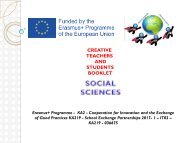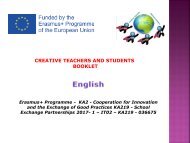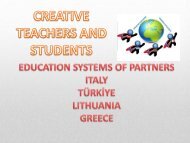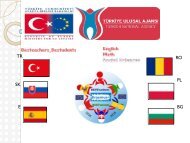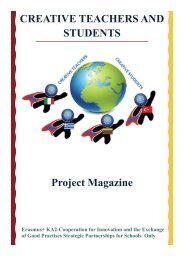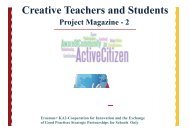besteachers,bestudents-math
You also want an ePaper? Increase the reach of your titles
YUMPU automatically turns print PDFs into web optimized ePapers that Google loves.
TR<br />
RO<br />
SK<br />
PL<br />
E<br />
BG
MATH TEACHING<br />
A- Strategies for Motivating Students in<br />
Mathematics<br />
B- Math Teaching Strategies<br />
A- Strategies for Motivating Students in<br />
Mathematics<br />
Motivating students to be enthusiastically receptive is one of<br />
the most important aspects of <strong>math</strong>ematics instruction and a<br />
critical aspect of any curriculum. Effective teachers focus<br />
attention on the less interested students as well as the<br />
motivated ones. Here are nine techniques—based on intrinsic and<br />
extrinsic motivation—that can be used to motivate secondary<br />
school students in <strong>math</strong>ematics
EXTRINSIC AND INTRINSIC MOTIVATION<br />
Extrinsic motivation involves rewards that occur outside the<br />
learner’s control. These may include token economic rewards for<br />
good performance, peer acceptance of good performance,<br />
avoidance of “punishment” by performing well, praise for good<br />
work, and so on.<br />
However, many students demonstrate intrinsic motivation in their<br />
desire to understand a topic or concept (task-related), to<br />
outperform others (ego-related), or to impress others (socialrelated).<br />
The last goal straddles the fence between intrinsic and<br />
extrinsic.<br />
With these basic concepts in mind, there are specific techniques<br />
that might be expanded, embellished, and adapted to the<br />
teacher’s personality and, above all, made appropriate for the<br />
learner’s level of ability and environment. The strategies are the<br />
important parts to remember—examples are provided merely to<br />
help understand the techniques.
STRATEGIES FOR INCREASING STUDENT MOTIVATION IN<br />
MATH<br />
1. Call attention to a void in students’ knowledge: Revealing to<br />
students a gap in their understanding capitalizes on their desire to learn<br />
more. For instance, you may present a few simple exercises involving<br />
familiar situations, followed by exercises involving unfamiliar situations<br />
on the same topic. The more dramatically you reveal the gap in<br />
understanding, the more effective the motivation.
2. Show a sequential achievement: Closely related to the preceding technique<br />
is having students appreciate a logical sequence of concepts. This differs from<br />
the previous method in that it depends on students’ desire to increase, not<br />
complete, their knowledge. One example of a sequential process is how special<br />
quadrilaterals lead from one to another, from the point of view of their<br />
properties<br />
3. Discover a pattern: Setting up a contrived situation that leads students to<br />
discover a pattern can often be quite motivating, as they take pleasure in<br />
finding and then owning an idea. An example could be adding the numbers from 1<br />
to 100. Rather than adding the numbers in sequence, students add the first and<br />
last (1 + 100 = 101), and then the second and next-to-last (2 + 99 = 101), and so<br />
on. Then all they have to do to get the required sum is solve 50 × 101 = 5,050.<br />
The exercise will give students an enlightening experience with a truly lasting<br />
effect. There are patterns that can be motivating, especially if they are<br />
discovered by the student—of course, being guided by the teacher.
4. Present a challenge: When students are challenged intellectually, they react with<br />
enthusiasm. Great care must be taken in selecting the challenge. The problem (if<br />
that is the type of challenge) must definitely lead into the lesson and be within<br />
reach of the students’ abilities. Care should be taken so that the challenge does<br />
not detract from the lesson but in fact leads to it.<br />
5. Entice the class with a “gee whiz” <strong>math</strong>ematical result: There are many<br />
examples in the <strong>math</strong>ematics realm that are often counterintuitive. These ideas by<br />
their very nature can be motivating. For example, to motivate basic belief in<br />
probability, a very effective motivation is a class discussion of the famous birthday<br />
problem, which gives the unexpectedly high probability of birthday matches in<br />
relatively small groups. Its amazing—even unbelievable—result will leave the class in<br />
awe.
6. Indicate the usefulness of a topic: Introduce a practical application of genuine<br />
interest to the class at the beginning of a lesson. For example, in high school<br />
geometry, a student could be asked to find the diameter of a plate where all the<br />
information he or she has is a section of the plate that is smaller than a semicircle.<br />
The applications chosen should be brief and uncomplicated to motivate the lesson<br />
rather than detract from it.<br />
7. Use recreational <strong>math</strong>ematics: Recreational motivation involves puzzles,<br />
games, paradoxes, or the school building or other nearby structures. In addition to<br />
being selected for their specific motivational gain, these devices must be brief and<br />
simple. An effective execution of this technique will allow students to complete the<br />
recreation without much effort. Once again, the fun that these recreational<br />
examples generate should be carefully handled, so as not to detract from the<br />
ensuing lesson.
8. Tell a pertinent story: A story of a historical event (for example, the story of<br />
how Carl Friedrich Gauss added the numbers from 1 to 100 within one minute when<br />
he was a 10-year-old in 1787) or a contrived situation can motivate students.<br />
Teachers should not rush while telling the story—a hurried presentation minimizes<br />
the potential motivation of the strategy.<br />
9. Get students actively involved in justifying <strong>math</strong>ematical curiosities: One of the<br />
more effective techniques for motivating students is to ask them to justify one of<br />
many pertinent <strong>math</strong>ematical curiosities, like the fact that when the sum of the<br />
digits of a number is divisible by 9, the original number is also divisible by 9. The<br />
students should be familiar and comfortable with the <strong>math</strong>ematical curiosity<br />
before you challenge them to defend it.<br />
Teachers of <strong>math</strong>ematics must understand the basic motives already present in<br />
their learners. The teacher can then play on these motivations to maximize<br />
engagement and enhance the effectiveness of the teaching process. Exploiting<br />
student motivations and affinities can lead to the development of artificial<br />
<strong>math</strong>ematical problems and situations. But if such methods generate genuine<br />
interest in a topic, the techniques are eminently fair and desirable.
Math Teaching Strategies<br />
1-Interacting with Peers<br />
Peer interactions can greatly benefit a student's understanding of <strong>math</strong>ematical<br />
concepts. To facilitate peer collaboration based on differentiated needs, teachers<br />
should pair students carefully, model effective ways to interact, provide students<br />
with relevant tools, and offer specific advice. Struggling students may find it<br />
especially helpful to interact with peers who can provide explanations, clarify a<br />
process, and ask and answer questions. This give and take involves listening,<br />
speaking, writing, creating visual representations, and using virtual and physical<br />
manipulatives.<br />
Interactıng Wıth Peers - Teach Wıth Tech Exploring <strong>math</strong> together -<br />
discussing, reading, and writing about concepts - can build your students’<br />
<strong>math</strong>ematical understanding. However, your students need your help to learn how to<br />
use their peers as resources, as well as how to be a useful resource for their peers.<br />
The strategies given here provide a strong starting point for differentiating<br />
instruction. Consider using digital communication methods such as blogs, emails, and<br />
text messages.
2-Math Language<br />
In <strong>math</strong>, students must build a shared understanding of <strong>math</strong>ematical terms to<br />
successfully share and refine their ideas. This can be challenging, because students<br />
must learn new words and symbols that are unique to <strong>math</strong>, as well as precise new<br />
meanings for words they are already familiar with. All students can benefit from<br />
differentiated instruction when learning terms and symbols. Struggling students<br />
may need more support and practice to gain confidence in their use of language.<br />
Math Language - Teach With Tech Math requires students to understand new<br />
terminology because common words and phrases can have <strong>math</strong>-specific meanings.<br />
Many words (such as “plus” and “equals”) are so common and important that we use<br />
symbols rather than words. Teaching precise <strong>math</strong>ematical language will help your<br />
students to think more carefully about their ideas and the ideas of their peers.<br />
The strategies below provide a strong foundation for differentiating instruction.
3-Modeling<br />
Models help promote <strong>math</strong>ematical thinking and facilitate an understanding of key<br />
concepts and <strong>math</strong>ematical structures. By seeing and moving objects, students<br />
engage their senses to better understand and reason with abstract concepts, or to<br />
make sense of and solve problems. Teachers can support students who struggle<br />
with abstraction by differentiating instruction using models. Virtual models provide<br />
a different sensory experience, which can be helpful for students who have<br />
difficulty with physical objects.<br />
Modeling - Teach with Tech Struggling students may miss the important step of<br />
connecting the physical model to the more general, abstract concept. Some<br />
students may also have difficulty translating from the problem to the model and<br />
back again to provide an answer. Implementing the strategies below can help you<br />
differentiate instruction.
4-Organizing<br />
Finding and understanding patterns is crucial to <strong>math</strong>ematical thinking and problem<br />
solving. It is easier for students to understand patterns when they organize their<br />
information. Struggling students may find it helpful to organize information in a<br />
problem because it requires a student to think more deeply about each piece of<br />
information and how those pieces fit together. Technology can significantly<br />
enhance organizational tools and provide support to students.<br />
Organizing - Teach With Tech Creating an organized list, table, chart, or other<br />
graphic organizer is an important problem-solving strategy Organizing information<br />
will help your students to see patterns and learn <strong>math</strong>ematical concepts more<br />
easily. Organizing will also give your students a structure to help them think about<br />
what they do and don’t know about a problem. The strategies below provide a<br />
strong starting point for differentiating instruction.
5-Supporting Science<br />
Mathematics helps us to understand science and to design, conduct, and analyze the<br />
results of scientific experiments. Science requires us to collect data, interpret it<br />
for significant patterns, and make conclusions that further our knowledge. To<br />
collect and analyze data, students must be able to apply <strong>math</strong>ematical content and<br />
practices. This includes selecting appropriate tools, using those tools to model the<br />
data by describing it <strong>math</strong>ematically, and reasoning both quantitatively (to<br />
understand the data itself) and abstractly (to draw conclusions).<br />
Supporting Science - Teach With Tech Students—especially those who<br />
struggle with <strong>math</strong>ematics—need varied and ongoing support to develop the ability<br />
to apply their <strong>math</strong>ematical abilities to science. Here are some ways to provide this<br />
support.
6-Thinking Aloud<br />
When students verbalize what they know, it helps them to reflect upon and clarify<br />
the problem and focus on one step at a time. “Thinking aloud” requires talking<br />
through the details, decisions, and the reasoning behind those decisions. Struggling<br />
students, in particular, can benefit from slowing down the process, because it gives<br />
them time to fully comprehend the problem. Technology can help create problems<br />
with natural stopping points that allow students to practice this “thinking aloud”<br />
strategy—that is, to experiment, consider, and then decide their next steps.<br />
Thinking Aloud - Teach with Tech Thinking aloud helps your students learn how<br />
to reason by focusing on their thinking Most students are not used to answering<br />
questions that require more than a single-word or short-phrase response. Many<br />
don’t know how to talk about <strong>math</strong>ematics or explain their thinking. These<br />
strategies provide a strong starting point for differentiating instruction.<br />
7-Understanding Problems<br />
For many students, <strong>math</strong>ematics word problems are just a jumble of words and<br />
numbers. A problem-solving process can help students make sense of problems.<br />
They can do this by reading the problem more than once, annotating words and<br />
numbers, visualizing the situation, converting visualizations into diagrams or<br />
<strong>math</strong>ematical expressions, and assessing the reasonableness of their solutions. All<br />
students need to apply problem solving to more and more complex situations as<br />
they move forward in their <strong>math</strong>ematical learning.<br />
Understanding Problems - Teach With Tech Learning how to solve word<br />
problems requires students to understand the context and then develop a strategy<br />
to solve the problem. Students build on their ability to organize, create visual<br />
representations, and use precise language. You can help your students build on<br />
these skills and understand how to use them in specific situations
8-Visual Representations<br />
All students can benefit from using visual representations, although struggling<br />
students may require extra support and practice. Visual representations are a<br />
powerful way for students to access abstract <strong>math</strong> ideas. Drawing a situation,<br />
graphing lists of data, or placing numbers on a number line all help to make abstract<br />
concepts more concrete, whether done online or offline. Developing this strategy<br />
early will give students tools and ways of thinking that they can use as they<br />
advance in their learning of more abstract concepts.<br />
Visual Representations - Teach With Tech Choosing the “right” visual<br />
representation often depends on content and context. In some contexts, there are<br />
multiple ways to represent the same idea. Your students need to view a variety of<br />
visual representations (see UDL Checkpoint 2.5: Illustrate through multiple media)<br />
in order to learn when and why they should choose each one. As you plan how to<br />
provide differentiated support and practice, consider ways technology tools can<br />
support the development of this critical practice.
Isparta Gazi Social Sciences High School TÜRKİYE<br />
Profılırana Gımnazıa Hrısto Botev<br />
BULGARIA<br />
Zespol Szkol Ogolnoksztalcacych nr 3 w Katowicach POLAND<br />
Lıceul Teoretıc Mırcea Elıade<br />
ROMANIA<br />
Stredna Odborna Skola Polnohospodarstva A Sluzieb Na<br />
Vidieku SLOVAKIA<br />
Centre Educatıu Balaguer<br />
SPAIN



